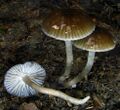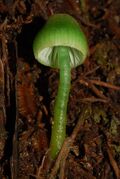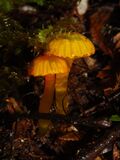Biology:Gliophorus
| Gliophorus | |
|---|---|

| |
| Gliophorus graminicolor | |
| Scientific classification | |
| Domain: | Eukaryota |
| Kingdom: | Fungi |
| Division: | Basidiomycota |
| Class: | Agaricomycetes |
| Order: | Agaricales |
| Family: | Hygrophoraceae |
| Genus: | Gliophorus Herink (1958) |
| Type species | |
| Gliophorus psittacinus (Schaeff.) Herink (1958)
| |
Gliophorus is a genus of agaric fungi in the family Hygrophoraceae. Gliophorus species belong to a group known as waxcaps in English, sometimes also waxy caps in North America or waxgills in New Zealand. In Europe, Gliophorus species are typical of waxcap grasslands, a declining habitat due to changing agricultural practices. As a result, two species, Gliophorus europerplexus and Gliophorus reginae, are of global conservation concern and are listed as "vulnerable" on the IUCN Red List of Threatened Species.[1]
Taxonomy
The genus was described by Czech mycologist Josef Herink in 1958.[2] It was formerly synonymized with Hygrocybe by many authorities,[3] but recent molecular research, based on cladistic analysis of DNA sequences, indicates that Gliophorus is monophyletic and forms a natural group distinct from Hygrocybe sensu stricto.[4][5][6][7]
Description
Species are distinguished from most other waxcaps by producing basidiocarps (fruit bodies) with extremely slimy or glutinous caps and stems.[8] The waxcap genus Gloioxanthomyces is superficially similar.
Habitat and distribution
In Europe, Gliophorus species are typically found in agriculturally unimproved, short-sward grasslands (including pastures and lawns).[3] Elsewhere, they are most frequently found in woodland. The genus is cosmopolitan, though New Zealand has an unusually large number of native Gliophorus species.[8]
Species
| Image | Scientific name | Distribution |
|---|---|---|
| G. bichromus | New Zealand | |
 |
G. chromolimoneus | New Zealand and Australia |
| G. europerplexus[5] | Wales, England, and Spain | |
| G. fumosogriseus | New Zealand | |
 |
G. glutinosus[9] | Sikkim |
 |
G. graminicolor | Australia and New Zealand |
 |
G. irrigatus[10] | Europe, Central and North America, northern Asia, and Australia |
 |
G. laetus | Europe, Central America, eastern and western North America |
| G. lilacinoides | New Zealand | |
 |
G. lilacipes | New Zealand |
| G. luteoglutinosus | Australia | |
| G. ostrinus | Mexico | |
| G. pallidus | New Zealand | |
 |
G. perplexus[5] | Mexico |
| G. pseudograminicolor[10] | Australia | |
 |
G. psittacinus | Europe, United Kingdom, Iceland, Greenland, the Americas, South Africa, Japan |
| G. reginae | England and Wales, Denmark, France, Slovakia, and Spain. | |
| G. roseus[11] | Panama | |
| G. subheteromorphus | New Zealand | |
| G. sulfureus | New Zealand | |
 |
G. versicolor | New Zealand |
 |
G. viridis | New Zealand |
 |
G. viscaurantius | New Zealand. |
References
- ↑ "Gliophorus. The IUCN Red List of Threatened Species". https://www.iucnredlist.org/search?taxonomies=126003040&searchType=species.
- ↑ Herink J. (1958). "Stavnatkovité houby parhorku "Velká Horka" u Mnichova Hradiste" (in Czech). Sborník Severoceského Musea 1: 53–86.
- ↑ 3.0 3.1 Boertmann D. (2010). The genus Hygrocybe (2nd ed.). Copenhagen: Danish Mycological Society. pp. 200. ISBN 978-87-983581-7-6.
- ↑ "Preliminary notes on dual relevance of ITS sequences and pigments in Hygrocybe taxonomy". Persoonia 26: 99–107. 2011. doi:10.3767/003158511X578349. PMID 22025807.
- ↑ 5.0 5.1 5.2 "Molecular phylogeny, morphology, pigment chemistry and ecology in Hygrophoraceae (Agaricales)". Fungal Diversity 64 (1): 1–99. 2014. doi:10.1007/s13225-013-0259-0.
- ↑ "Gliophorus Herink". Index Fungorum. CAB International. http://www.indexfungorum.org/Names/NamesRecord.asp?RecordID=17657. Retrieved 2011-10-05.
- ↑ "Gliophorus Herink 1958". MycoBank. International Mycological Association. http://www.mycobank.org/MycoTaxo.aspx?Link=T&Rec=17657. Retrieved 2011-10-05.
- ↑ 8.0 8.1 Horak E. (1990). "Monograph of the New Zealand Hygrophoraceae (Agaricales)". New Zealand Journal of Botany 28 (3): 255–309. doi:10.1080/0028825x.1990.10412313. http://www.royalsociety.org.nz/media/publications-journals-nzjb-1990-029.pdf.[yes|permanent dead link|dead link}}]
- ↑ Chakraborty, Dyutiparna; Das, Kanad; Vizzini, Alfredo (2018). "Gliophorus glutinosus sp. nov. (Hygrophoraceae, Agaricales) from Eastern Himalayan region of India". MycoKeys 44 (44): 123–135. doi:10.3897/mycokeys.44.28554. PMID 30613182.
- ↑ 10.0 10.1 Paul M. Kirk (10 September 2013). "Nomenclatural novelties". Index Fungorum (23): 1. ISSN 2049-2375. http://www.indexfungorum.org/Publications/Index%20Fungorum%20no.23.pdf.
- ↑ Reschke, K., Lotz-Winter, H., Fischer, C.W., Hofmann, T.A., Piepenbring, M., 2021. New and interesting species of Agaricomycetes from Panama. Phytotaxa 529, 1–26. https://doi.org/10.11646/phytotaxa.529.1.1
Wikidata ☰ Q5569788 entry
 |

